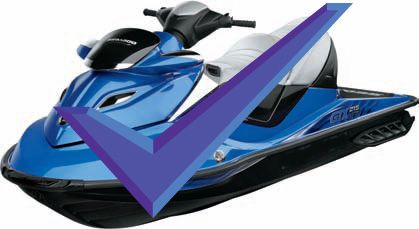| Use | Prep | Post-Ride | Storing |
What is a PWC?
Laws & Rules
Places to Ride
Photo Gallery
It’s about that time of year again, temperatures are on the rise and the last remnants of winter are fading away. This can mean only one thing – it’s almost BIKINI SEASON! Time to get your PWC ready for some aquatic fun!
 General Tips on How to Prepare Your Personal Watercraft for Summer Fun
General Tips on How to Prepare Your Personal Watercraft for Summer Fun
The following pre summer fun inspection assumes that your PWC had proper winterizing service performed. Performing a quick pre and post ride inspection will help ensure that you have a fun and safe time on the water this summer.
BATTERY – Check the water level of the battery and add DISTILLED water as necessary (not required on maintenance free or gel type batteries). If the battery has not been on a Battery Tender Jr. over the winter months or the battery has fully discharged and been subjected to freezing temperatures, you may want to consider replacing it. (Floating aimlessly in the middle of the lake with a dead battery and not a boat in sight, does not promote aquatic fun) Inspect the battery cable and starter connections for signs of corrosion and clean as required. Apply a thin coat of dielectric contact grease, if available, to ensure a better electrical contact and help reduce future corrosion. Place the battery on a low amp, trickle battery charger to ensure it’s fully charged.
Please Note: Jump starting your personal watercraft off a car battery can cause serious damage to the electronics - If you MUST jump from a car, (i.e. bikinis have been sighted) make sure that the car engine is not running.
CONTROL SYSTEMS – Make sure all operating controls including the steering controls, start/stop button, lanyard and throttle are working properly. The steering and throttle should move freely without any evidence of sticking or binding. Be sure to check the throttle in all steering positions. If your watercraft is equipped with a reverse system, make sure the reverse lever operates smoothly without binding and the reverse bucket drops down over the jet pump nozzle. Lube or replace cables as required. Note: you will need a special tool called a cable luber to lube the cables.
FUEL – The fuel in the gas tank (without fuel stabilizer) will tend to degrade over time and depending on how long the ski has been sitting you may want to siphon out some or all of the gas and replace it with fresh gas before trying to start the beast. Dispose of the old gas in an ‘environmentally friendly way’ or save it for future use in your weed whacker or lawn mower. Inspect the fuel filter. Fuel filters are cheap insurance for the life of your engine if yours looks questionable, replace it.
OIL - If your PWC is equipped with an oil injection system be sure and top off to oil tank. If you have a 4 stroke engine (4-Tec, etc), check the oil level using the dip stick. It’s generally best to stick with the oil recommended by your watercrafts manufacturer. Please note that not all “2 stroke oil” is the same and using the incorrect one can damage your pride and joy’s engine.
ENGINE COMPARTMENT – Grab a bright flash light or shop light and spend some time inspecting the inside of your engine compartment for evidence of fuel or oil leaks, broken or missing hose clamps and tie wraps, loose or frayed wiring, and worn or cracked hoses. Give all hose clamps, hood, seat, sponsons and tie down bolts a quick once over with a screw driver or wrench to ensure they are tight.
HULL – Inspect the outside of your PWC for any damage to the hull. Minor chips and scrapes are usually not a problem. Inspect the jet pump intake grate area for any lake debris (wood, plastic bags, alligators) that may have become lodged there last riding season. While you are under your PWC, check/tighten the bolts securing the intake grate. Shine your light source in the exit nozzle looking for signs that your PWC may have ingested anything other than good ole H20.
FIRE IT UP! – If you went a little over board with the fogging oil last winter, you may want to remove the spark plugs and hold a shop rag over the plug holes while bumping the starter a few times. Remember to properly ground the spark plug wires before trying the starter! When the shop rag doesn’t look like it was used to clean up the Exxon Valdes oil spill, replace the plugs and turn the fuel selector on.
Try the starter for a max of 5 seconds at a time. Allowing time in between try’s for the starter to cool. Tip: If you’re having a hard time starting your jet ski you may want to try spraying some WD-40 in the intake while cranking to help it start. (WD-40 is less harsh on the engine than ether starting spray.) Once you get the watercraft running, turn the handlebar all the way to the left and right to ensure that the idle speed does NOT change (i.e. checking for a binding throttle cable). Run the engine for a max of 15-20 seconds then allow the engine to cool completely.
Great it’s running, time to head to the lake!
Before packing up the ole’ tow vehicle with life vests and sun block take a few minutes to check your safety equipment. Check your fire extinguisher, horn / whistle, life vests, tow rope, trailer safety chains, extra lanyard, etc to see if it’s in proper working order.